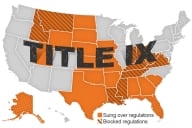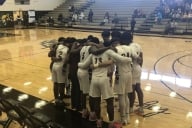You have /5 articles left.
Sign up for a free account or log in.
The National Collegiate Athletic Association claims that to share the revenue it gains from the use of athletes' images, names and likenesses with the athletes themselves would threaten the amateur model of college sports -- an assertion that will soon be tested in a landmark lawsuit making its way through the court. Ed O'Bannon, a former basketball star at the University of California at Los Angeles, filed a class action in 2009 that -- if a court rules athletes are entitled to a share of that money -- could, in the most extreme scenario, trigger a fundamental shift in how the NCAA operates and even lead to the dissolution of the organization.
So the arguments in a report published Monday -- that to share revenue with athletes would be fiscally possible and that the NCAA's definition of amateurism has changed numerous times as college sports has grown into a mass commercial enterprise -- are particularly timely.
"In short, amateurism in intercollegiate athletics is whatever the NCAA says it is," reads the report, written by Andrew Zimbalist, an economics professor at Smith College, and Allen Sack, president of the Drake Group, which advocates for academic integrity and greater balance in college athletics. "The NCAA maintains its own, idiosyncratic, changing, frequently arbitrary, and often illogical definition of amateurism. NCAA restrictions on college athletes' free participation in the lucrative market for their images, likenesses and names are obviously not necessary to uphold the principles of amateurism, which are constantly changing to meet industry needs."
When students become athletes, they sign an agreement with the NCAA that essentially gives the association ownership over their names and images. The NCAA and video game companies can profit from using photos of the athletes or images that strongly resemble them for as long as they like, and the athletes never see a penny.
Sack, a professor of sport management at the University of New Haven, said that to share this revenue with athletes "is no more a violation of amateurism than paying for their educations, or conditioning the renewal of their scholarships each year on athletic performance."
Responding to a request for comment, NCAA spokesman Erik Christianson said the association had not seen or reviewed the report. "Amateurism is what separates college sports from pro sports, and the NCAA membership has decided that those who participate in intercollegiate athletics should be students first and not paid professional athletes," he said. "The NCAA does not limit how a student-athlete takes advantage of his or her likeness after college."
When the NCAA was founded in 1905, it adopted a truly pure position on amateurism, prohibiting universities from offering athletes any sort of inducements to attend stemming from their athletic abilities. Athletic scholarships were forbidden, and an amateur athlete was defined as "one who participates in competitive physical sports only for the pleasure, and the physical, mental, moral and societal benefits derived therefrom."
Of course, that's a far cry from the big-time college sports of today, in which athletes are lured to campuses with full-ride tuition, private tutoring and lavish facilities; scholarship renewal is contingent upon athletic participation; and coaches make millions a year based on their ability to bring in the best athletes and get them to perform.
Today, "pay for play" refers to compensating an athlete as an employee. Before 1957, it meant awarding athletic scholarships. That year, the NCAA coined and mandated the term "student athlete" as part of an effort to protect itself from workers' compensation claims.
As college sports grew and became less a campus extracurricular than a lucrative business enterprise, programs complained about and violated rules so often that the NCAA took step after step away from its original notion of amateurism, allowing athletic scholarships in 1948 and termination of financial aid if a student stopped playing in 1967, permitting coverage of educational expenses in 1957, and prohibiting multiyear scholarships in 1973.
That "final break" from the traditional model of amateurism "transformed athletes into highly specialized entertainers," the Drake report says. "The contractual nature of this relationship and the control it gives coaches over the player's behavior has many of the trappings of an employment contract.... The drift away from earlier amateur practices has not detracted from its popularity as commercial entertainment, and the NCAA's ability to arbitrarily define what constitutes amateurism ensures that increasing subsidies to athletes will not" -- contrary to the NCAA's assertions -- "pose a threat to the NCAA's brand of 'amateur sport.' "
Further, while the NCAA prohibits athletes from accepting any sort of sponsorship or performance-related payment, it does allow players in football bowl games and the annual basketball tournament to accept thousands of dollars in gifts from their colleges and athletic conferences.
The report also counters the NCAA's assertion that paying athletes for use of their likeness would destroy competitive equity (a notion the association itself took a huge step away from under its new regulatory philosophy) and is not financially viable for universities.
Programs are already vastly unequal, the report says, with Division I institutions collecting 61 percent of the revenue redistributed by the NCAA in 2011-12, despite making up only 32 percent of the associations' members. Those institutions also maintain significantly more power in the association's governance structure and access to the football Bowl Championship Series, which in turn brings them more revenue.
While those top programs enjoy more and more revenue that inevitably translates into more lucrative contracts for coaches who are already being paid millions, the less elite ones play catch-up through other means: institutional, government and student-paid subsidies. That component of athletic revenue grew from 22 percent at Football Bowl Series institutions in 2003 to 34.5 percent in 2010, the report says, with subsidies ranging from $3.4 million at the top programs to $13.6 million at the bottom ones.
"Restructuring these NCAA distributions," the report reads, "would be desirable not only from the perspective of competitive balance, financial solvency and blunting the incentives toward commercialism, but also from the perspective of encouraging the schools' focus on educational outcomes."
But even without a change such as that, programs already waste millions of dollars that could be redistributed to athletes for use of their likeness without breaking the athletic department bank or harming competitive balance.
That money is found in the multimillion-dollar salaries and benefits enjoyed by top-tier coaches, which Zimbalist and Sack say is directly attributable to amateurism: instead of athletes getting paid for their work, coaches get paid for the value they bring through recruiting.
Limiting FBS scholarships to 60 (the current maximum is 85) could save $1.5 million a year for the typical program, the report says, and halving the excess expenditures found at Division I programs could save nearly $3 million per institution.








